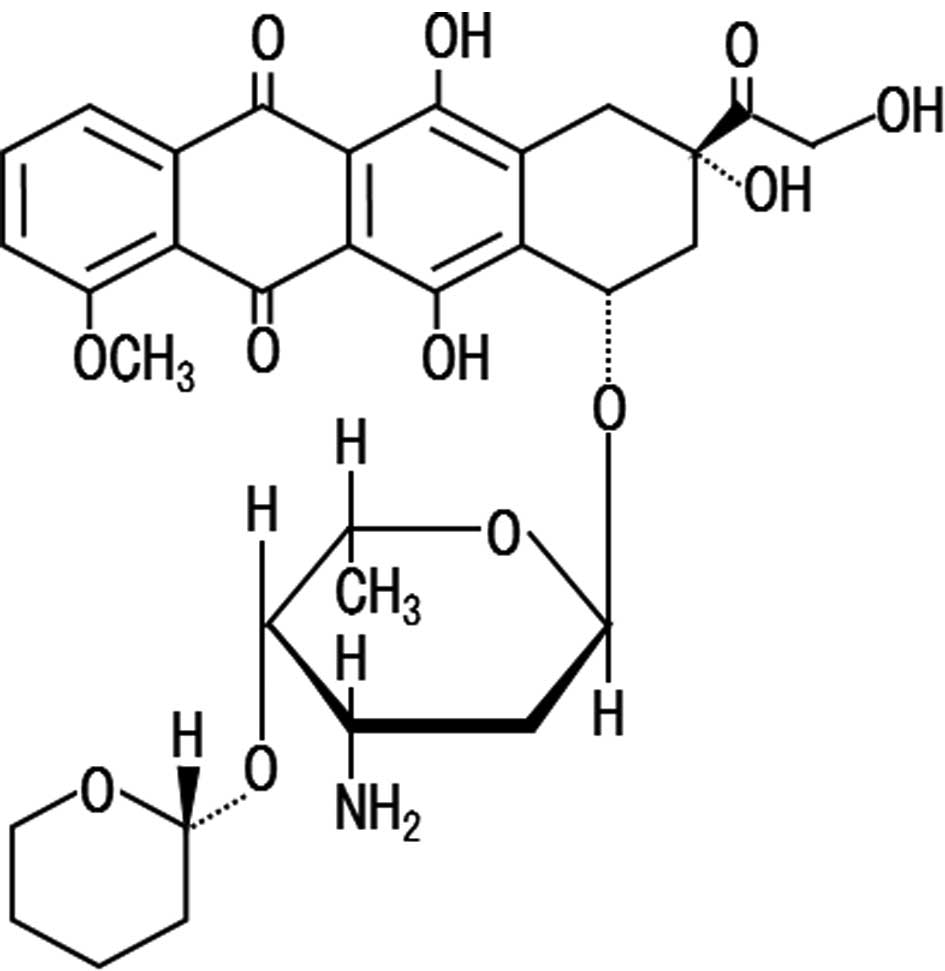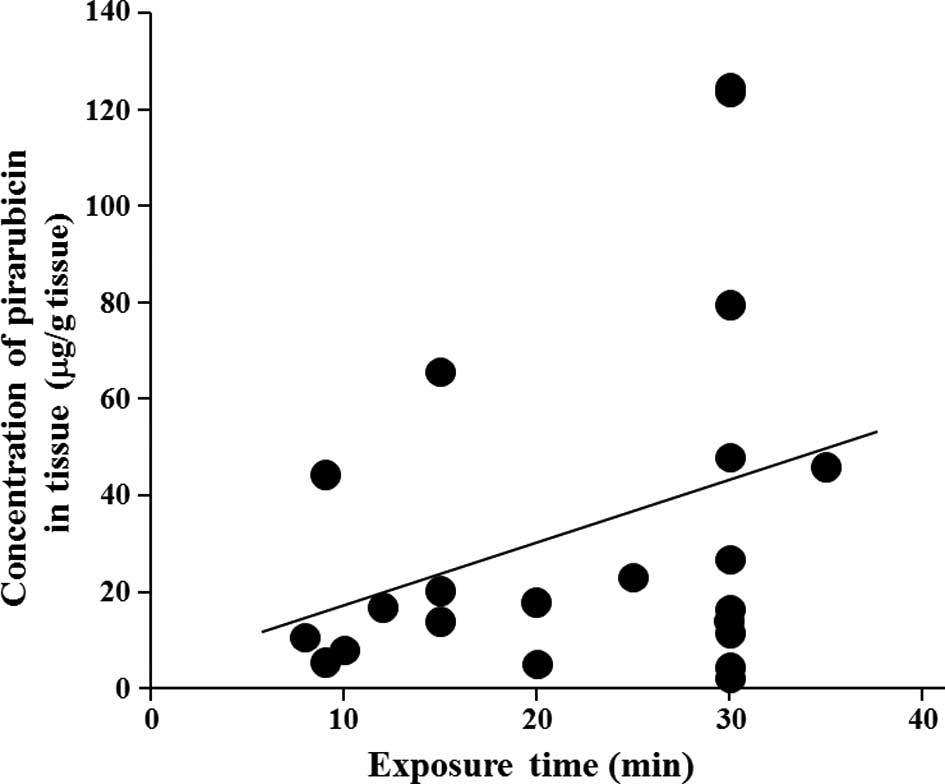|
1.
|
Lutzeyer W, Rubben H and Dahm H:
Prognostic parameters in superficial bladder cancer: an analysis of
315 cases. J Urol. 127:250–252. 1982.PubMed/NCBI
|
|
2.
|
Herr HW, Laudone VP and Whitmore WF: An
overview of intravesical therapy for superficial bladder tumors. J
Urol. 138:1363–1368. 1987.PubMed/NCBI
|
|
3.
|
Miki T, Nonomura N, Kojima Y, et al: A
randomized study on intravesical pirarubicin (THP) chemoprophylaxis
of recurrence after transurethral resection of superficial bladder
cancer. Hinyokika Kiyo. 43:907–912. 1997.(In Japanese).
|
|
4.
|
Sylvester RJ, van der MA and Lamm DL:
Intravesical bacillus Calmette-Guerin reduces the risk of
progression in patients with superficial bladder cancer: a
meta-analysis of the published results of randomized clinical
trials. J Urol. 168:1964–1970. 2002. View Article : Google Scholar
|
|
5.
|
Lamm DL, Blumenstein BA, Crawford ED, et
al: A randomized trial of intravesical doxorubicin and
immunotherapy with bacille Calmette-Guérin for transitional-cell
carcinoma of the bladder. N Engl J Med. 325:1205–1209.
1991.PubMed/NCBI
|
|
6.
|
Witjes JA, Meijden AP, Sylvester LC,
Debruyne FM, van Aubel A and Withes WP: Long-term follow-up of an
EORTC randomized prospective trial comparing intravesical bacilli
Calmette-Guerin-RIVM and mitomycin C in superficial bladder cancer.
EORTC GU Group and the Dutch South East Cooperative Urological
Group European Organisation for Research and Treatment of Cancer
Genito-Urinary Tract Cancer Collaborative Group. Urology.
52:403–410. 1998.
|
|
7.
|
Soloway MS, Sofer M and Vaidya A:
Contemporary management of stage T1 transitional cell carcinoma of
the bladder. J Urol. 167:1573–1583. 2002. View Article : Google Scholar : PubMed/NCBI
|
|
8.
|
Oosterlinck W, Kurth KH, Schröder F,
Bultinck J, Hammond B and Sylvester R; Members of the European
Organization for Research and Treatment of Cancer Genitourinary
Group: A prospective European organization for research and
treatment of cancer genitourinary group randomized trial comparing
transurethral resection followed by a single intravesical
instillation of epirubicin or water in single stage Ta, T1
papillary carcinoma of the bladder. J Urol. 149:749–752. 1993.
|
|
9.
|
Tolley DA, Parmar MK, Grigor KM, et al:
The effect of intravesical mitomycin C on recurrence of newly
diagnosed superficial bladder cancer: a further report with 7 years
of follow-up. J Urol. 155:1233–1238. 1996.PubMed/NCBI
|
|
10.
|
Rajala P, Liukkonen T, Raitanen M, Rintala
E, Kaasinen E, Helle M and Lukkarinen O: Transurethral resection
with perioperative instillation of interferon-α or epirubicin for
the prophylaxis of recurrent primary superficial bladder cancer: a
prospective randomized multicenter study-Finnbladder III. J Urol.
161:1133–1136. 1999.
|
|
11.
|
Solsona E, Iborra I, Ricós JV, Monrós L,
Casanova J and Dumont R: Effectiveness of a single immediate
mitomycin C instillation in patients with low risk superficial
bladder cancer: short and long-term followup. J Urol.
161:1120–1123. 1999. View Article : Google Scholar
|
|
12.
|
Zincke H, Utz DC, Taylor WF, Myers RP and
Leary FJ: Influence of thiotepa and doxorubicin instillation at
time of transurethral surgical treatment of bladder cancer on tumor
recurrence: a prospective, randomized double-blind, controlled
trial. J Urol. 129:505–509. 1983.
|
|
13.
|
Prout GR, Koontz WW, Coomms LJ, Hawkins IR
and Friedell GH: Long-term fate of 90 patients with superficial
bladder cancer randomly assigned to receive or not to receive
thiotepa. J Urol. 130:677–680. 1983.PubMed/NCBI
|
|
14.
|
Fukushima T, Ueda T and Nakamura T:
Pharmacokinetics and action mechanism of anthracyclines. Gan To
Kagaku Ryoho. 19:445–450. 1992.(In Japanese).
|
|
15.
|
Akaza H, Niijima T, Hisamatsu T and
Fujigaki M: Comparative investigation on use of
(2′′R)-4′-O-tetrahydropyranyl-adriamycin and adriamycin as
intravesical chemotherapy for superficial bladder tumors. Urology.
32:141–145. 1988.
|
|
16.
|
Kunimoto S, Miura K, Takahashi Y, Takeuchi
T and Umezawa H: Rapid uptake by cultured tumor cells and
intracellular behavior of 4-O-tetrahydropyranyladriamycin. J
Antibiot. 36:3123–3117. 1983.(In Japanese).
|
|
17.
|
Okamura K, Ono Y, Kinukawa T, et al:
Nagoya University Urological Oncology Group. Randomized study of
single early instillation of
(2′′R)-4-O-tetrahydropyranyl-doxorubicin for a single superficial
bladder carcinoma. Cancer. 94:2363–2368. 2002.PubMed/NCBI
|
|
18.
|
Nakagawa S, Kojima M, Takeda H, Sugimoto
K, Mikami K and Watanabe H: Short-duration bladder instillation
therapy with pirarubicin for superficial bladder tumor based on
pharmacodynamic study. Gan To Kagaku Ryoho. 19:1837–1877. 1992.(In
Japanese).
|
|
19.
|
Sugano O, Hatakeyama T and Kato H:
Investigation of retention time of intravesical instillation
therapy with pirarubicin (THP). Gan To Kagaku Ryoho. 23:1169–1174.
1996.(In Japanese).
|
|
20.
|
Kanayama H, Yokota K, Kurokawa Y, et al:
Postoperative prophylactic intravesical instillation of
tetrahydropyranyl-adriamycin (THP) for superficial bladder cancer.
Gan To Kagaku Ryoho. 26:651–655. 1999.(In Japanese).
|
|
21.
|
Kuwano M, Toh S, Uchiumi T, Takano H,
Kohno K and Wada M: Multidrug resistance-associated protein
subfamily transporters and drug resistance. Anticancer Drug Des.
14:123–131. 1999.PubMed/NCBI
|
|
22.
|
Hasegawa S, Abe T, Naito S, et al:
Expression of multidrug resistance-associated protein (MRP), MDR1
and DNA topoisomerase II in human multidrug-resistant bladder
cancer cell lines. Br J Cancer. 71:907–913. 1995. View Article : Google Scholar
|
|
23.
|
Kimiya K, Naito S, Soejima T, Sakamoto N,
Kotoh S, Kumazawa J and Tsuruo T: Establishment and
characterization of doxorubicin-resistant human bladder cancer cell
line, KK47/ ADM. J Urol. 148:441–445. 1992.PubMed/NCBI
|
|
24.
|
Naito S, Kotoh S, Omoto T, et al: The
Kyushu University Urological Oncology Group: Prophylactic
intravesical instillation chemotherapy against recurrence after a
transurethral resection of superficial bladder cancer: a randomized
controlled trial of doxorubicin plus verapamil versus doxorubicin
alone. Cancer Chemother Pharmacol. 42:367–372. 1998.
|
|
25.
|
Tada Y, Wada M, Migita T, et al: Inceased
expression of multidrug resistance-associated proteins in bladder
cancer drug clinical course and drug resistance to doxorubicin. Int
J Cancer. 98:630–635. 2002. View Article : Google Scholar : PubMed/NCBI
|
|
26.
|
Maruyama T, Higuchi Y, Suzuki T, Qiu J,
Yamamoto S and Shima H: Double short-time exposure to pirarubicin
produces higher cytotoxicity against T24 bladder cancer cells. J
Infect Chemother. 17:11–16. 2010. View Article : Google Scholar
|
|
27.
|
Yamamoto Y, Nasu Y, Saika T, Aaeda T,
Tsushima T and Kumon H: The absorption of pirarubicin instilled
intravesicaly immediately after transurethral resection of
superficial bladder cancer. BJU Int. 86:802–804. 2000. View Article : Google Scholar : PubMed/NCBI
|
















